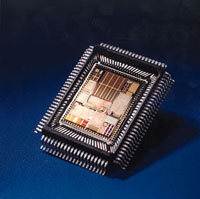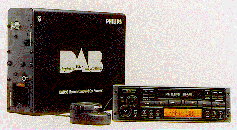
 |
JPL's Wireless Communication Reference WebsiteChapter: Analog and Digital Transmission |
The first systems using MCM were military HF radio links in the late 1950s and early 1960s. A special form of MCM, Orthogonal Frequency Division Multiplexing (OFDM), with densely spaced subcarriers with overlapping spectra of the modulating signal, was patented in the U.S. in 1970. OFDM abandoned the use of steep bandpass filters that completely separated the spectrum of individual subcarriers, as it was common practice in older Frequency Division Multiplexing systems (e.g. in analogue SSB telephone trunks) and still occurs in (asynchronous) Frequency Division Multiple Access (FDMA) private radio systems. Instead, OFDM time-domain waveforms are chosen such that mutual orthogonality is ensured even though spectra may overlap. It appeared that such waveform can be generated using a Fast Fourier Transform at the transmitter and receiver. For a relatively long time, the practicality of the concept appeared limited. Implementation aspects such as the complexity of a (Fast) Fourier Transform, appeared prohibitive, not to speak about other problems, such as the stability of oscillators in transmitter and receiver, the linearity required in RF power amplifiers, and the power back-off associated with this.
After many years of further intensive research in the 1980's, today we appear to be on the verge of a breakthrough of MCM techniques. Many of the implementational problems appear solvable and MCM has become part of several standards.
It was known from earlier experiments with wireless data transmission that the selection of the modulation technique is highly critical. In the early days of mobile communications, many attempts to connect a telephone modem to a cellular phone failed miserably, mainly because of the poor anticipation to the mobile channel anomalies. Although entrepreneurs rapidly recognized the demand for wireless data communications, experiments and product tests rapidly revealed that the mobile fading channel needed specific solutions, for modulation scheme, bit rates and the packet length. Among the many proposals, Multi- Carrier Modulation appeared one of the most elegant solutions for wireless digital transmission at high symbol rate. The signal waveform used for Multi- Carrier transmission has intriguing properties. The rapid increase in digital signal processing power in (software programmable) radio receivers has opened the way for large scale use of this idea. Nowadays this method is considered to be particularly suitable for high-performance digital radio links.
 The
concept of Orthogonal Frequency Division Multiplexing (OFDM) for Digital Audio
Broadcasting (DAB) goes back
to the end of the 1980s. Nowadays, experimental systems are in operation, and
introduction to the mass-audience is soon to follow. It may substantially improve
mobile reception of radio broadcasts. Chipsets for DAB are now being developed
in the European JESSE project, a necessary step towards mass production of receivers
at low price.
The
concept of Orthogonal Frequency Division Multiplexing (OFDM) for Digital Audio
Broadcasting (DAB) goes back
to the end of the 1980s. Nowadays, experimental systems are in operation, and
introduction to the mass-audience is soon to follow. It may substantially improve
mobile reception of radio broadcasts. Chipsets for DAB are now being developed
in the European JESSE project, a necessary step towards mass production of receivers
at low price.
Marketeers previously noticed that the introduction of a new technology is often more successful if it replaces an old existing service than if it only offers previously unknown services. But in our personal opinion, improved mobile radio reception by itself may not guarantee the real breakthrough of digital broadcasting. A lesson learned from High-Definition Television (HDTV) was that quality of reception is not the main motivation for customers to replace their equipment. However novel multi-media oriented services can easily be introduced once DAB is operational, which may appear to be a substantial market.
 Presumably,
one of the reasons to choose OFDM as the DAB standard was the possibility to
deploy single frequency networks. As MCM is robust against fading caused by
natural multipath, it can also work if signals are received from two different
transmitter sites: the mutual interference is simply experienced as artificial
multipath reception. This possibility guarantees very efficient use of scarce
radio spectrum, particularly if nationwide coverage is aimed at.
Presumably,
one of the reasons to choose OFDM as the DAB standard was the possibility to
deploy single frequency networks. As MCM is robust against fading caused by
natural multipath, it can also work if signals are received from two different
transmitter sites: the mutual interference is simply experienced as artificial
multipath reception. This possibility guarantees very efficient use of scarce
radio spectrum, particularly if nationwide coverage is aimed at.
As far as we can see, business plans for the introduction of DTTB appear not yet to be fully worked out. Mobile reception of television broadcasts may not justify the enormous costs of replacing the broadcast infrastructure: within DVB, marketing interests appear to focus on provision of television services over cable, the twisted pair telephone subscriber loop, or directly via satellite.
MCM was not adopted as a standard for the European HIgh PErformance Radio LAN (HIPERLAN), presumably because of the need for highly linear RF amplifiers which are difficult to build with the limited power available for PCMCIA add- ons. However, HIPERLAN II and the Wireless 1394 standards adopted OFDM transmission.
The deregulation of the use of Industrial Scientific and Medical (ISM) bands for communication allows many manufacturers to develop their own wireless equipment, independent of the time-consuming standardization processes, that are mostly dominated by commercial interests of a few major players. It is particularly in this field that many small companies in the U.S. are researching novel modulation methods and improved access methods, including OFDM and MC-CDMA.